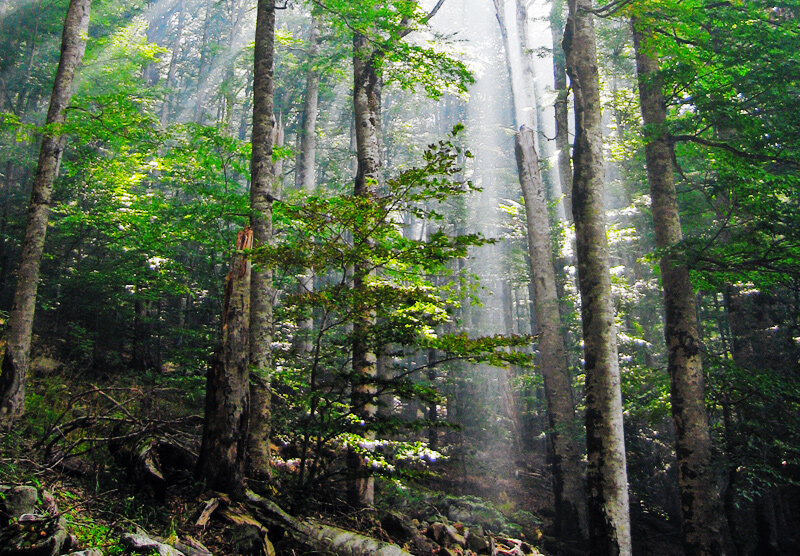THE WOMAN WHO SAVES OLD GROWTH
“This is not our world with trees in it. It’s a world of trees, where humans have just arrived.”
THE EASTERN SHORE — For two decades, Joan Maloof told her students that no old growth forests remained in Maryland. Then one day, the professor whom students called a “treehugger” heard about twenty acres of old growth a short drive away.
Twenty acres is scarcely a forest, Maloof knew, but she went in search. Down winding roads that turned from asphalt to gravel to dirt, she drove through newer forests. Finally, parking on an empty path, she stepped straight into time. The cathedral of trees seemed to welcome her, first with muffled silence, then with a “sweet, rich, earthy smell.” She walked and walked. She was never the same again.
When Europeans first approached the Eastern Shore, the scent from ancient forests met them miles out to sea. Today, however, Old Growth is nearly gone. Just five percent of uncut forests remain in the West, one percent in the East. Joan Maloof knows the numbers and she is determined to preserve the treasures still left.
Since 2011, the Old Growth Forest Network has grown from a single protected forest into 100-plus preserves coast-to-coast. And Maloof, like some Lorax speaking for the trees, has guided the network with her deep love of “the ancients.”
“I want to tell people that forests are important. When you’re looking at trees, you’re looking at embodied carbon. And it’s not just climate change. The forest is habitat for so many species. It’s cleaning the air. It’s water—water is cleaner after it flows through a forest. Forests are places of beauty and inspiration for humans. And all these roles are amplified the older a forest gets.”
Growing up in suburban Delaware, Maloof played in groves of hemlock and birch. “I didn’t know any of the trees,” she recalled. “I didn’t know anything about them, it was just the forest, and I loved it.”
After she studied plant science, then earned a doctorate in Ecology, she might have settled for tenure track. But by 1980, new environmental alarms were sounding. The alarm that awoke Maloof was nuclear, but as that threat waned, global warming began tolling. Then Maloof stepped into old growth.
Within a year of her first close encounter, Maloof published her first book. Teaching the Trees was more than another treehugger manifesto. Embracing that Limbaugh label, Maloof writes about taking students into the forest and insisting that they hug a tree. Some are nervous, afraid, mocking. Putting their arms around a pine or spruce, most are unmoved. But “because they have hugged a tree,” she writes, “they share the label. . . They will never be able to use that term derisively because they, too, have hugged a tree.”
In the groves of academe, Maloof’s book, weaving her own insights with poems by Rilke, stood tall. “A work of love and wonder,” one critic wrote, “crowned by a high, overarching intelligence.” Encouraged, Maloof kept teaching, kept writing. But Old Growth kept disappearing.
Then in 2010, Maloof threw an old mattress in an old pickup and set out to visit every old growth forest in the East. Her second book, Among the Ancients, told of her trip and inspired her to do more than write.
The green waters of environmentalism seemed overflowing. Greenpeace. The Sierra Club. The Nature Conservancy. Etc. But none focused solely on old growth until Maloof started the Old Growth Forest Network. Leaving academia, speaking out, working with activists, Maloof has grown her local concern into a nationwide network.
In 2021, when a grove near Dummerston, Vermont was preserved, the network reached half of the fifty states. Now for the other half. Maloof’s goal is to preserve at least one forest in every county in America. To reach that goal, Maloof and her staff need local treehuggers. The network’s website includes a How to Save a Forest Toolkit with guidelines for state and federal land use laws. And anyone can “nominate a forest.”
Why Old Growth? It’s more than atmosphere and affection, Maloof explains. An uncut forest is a breeding ground for biodiversity. Fallen trees, hollowed out trees, “grandfather trees” give life to plants, animals, fungi, lichen, and mosses. And then there is the human benefit, saving the trees in order to save ourselves. “The forest is not only something to be understood,” Maloof says. “It is something to be felt.”
So how can you join the network? Maloof offers simple steps. 1. Become familiar with a forest, one you usually drive by. Stop, walk through, see how the trees are doing. 2. Find out who owns it. 3. Contact the owners, state, county, or private. Ask if this wonder is protected. 4. If not, contact friends, locals, newspapers, and see what can be done. Use the network’s toolkit. Nominate your forest. And appreciate the trees, even if you’re not a hugger
“Because otherwise,” Maloof says, “you might be driving down the road, seeing that forest every day, and then one day it’s all cut to the ground, and you think ‘Oh no, what happened? Who owns this?’ And then it’s too late.”













